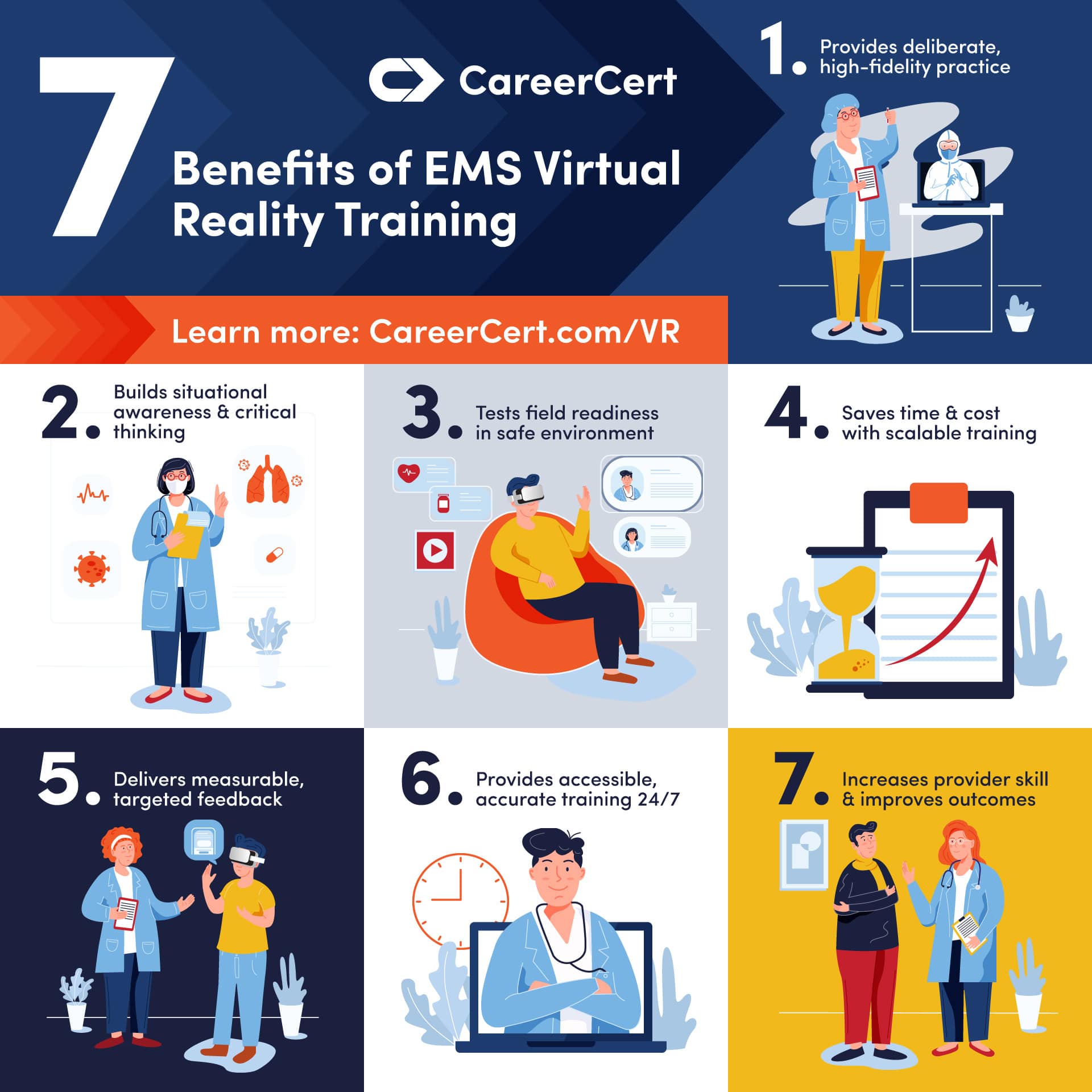How Virtual Reality Is Transforming EMS Training + 6 Benefits
 The future is here! Like Captain Kirk testing his wits in an immersive simulation, EMS personnel can now flex their lifesaving abilities in virtual space. Virtual reality (VR) technology is an exciting development in EMS education with a myriad of benefits. Highlighted below are just a few:
The future is here! Like Captain Kirk testing his wits in an immersive simulation, EMS personnel can now flex their lifesaving abilities in virtual space. Virtual reality (VR) technology is an exciting development in EMS education with a myriad of benefits. Highlighted below are just a few:
1. Provides deliberate practice that builds skill in a safe environment.
VR develops the “advanced cognitive skills required for EM triage, prioritization, and multi-patient management” without actual patients.1 Maintaining patient safety while preparing students to administer expert care is a longstanding challenge of healthcare education. Luckily, pixel-bodied patients sustain no long-lasting injury or death at the hands of students. In addition, providers are protected from training accidents, hazardous materials, or possible exposure that can result from hands-on training.
The fight against the novel coronavirus continues to illustrate the need for remote training technologies. Educators have struggled to provide students with clinical opportunities because of unprecedented strain on our healthcare systems and the desire to protect both patients and students from possible exposure. Where deemed appropriate, VR may replace clinical experience2 as it provides high-fidelity, deliberate practice in a safe environment.
2. Offers convenient, remote access to realistic simulations.
Team communication is a vital component of effective emergency care as professionals from multiple specialties coordinate treatment. With VR, no schedules need consulting to assemble a team together! VR supplies plenty of participants to facilitate COVID-free, interactive learning. Improvements in speech recognition technology mean that students can speak naturally instead of relying upon preselected questions and answers in medical interviews.1 Virtual peer substitutes may also boost confidence by mitigating social anxiety and performance pressure.
3. Prevents skill deterioration and provides practice in high-risk, low-frequency situations.
Research reveals rapid skills deterioration within months without review or use.3 VR is conducive for practice by allowing students to repeat assessments until competent with no time limits or a set number of attempts. Targeted feedback identifies mistakes and prompts students to correct them either in simulation or afterward during a performance review. More traditional patient‐based simulations using mannequins require direct observation by faculty to generate similar feedback.1
Students typically only practice high-risk, low-frequency skills by chance.2 Endotracheal intubation is an example of a high-risk skill where a lack of prehospital practice may contribute to a 25% misplaced endotracheal tube rate among paramedics.4 VR’s 3-dimensional viewing and interaction capabilities make practicing this vital trauma skill routine and risk-free.
Before VR, there weren’t practical ways for first responders to prepare for infrequent pediatric calls or mass casualty events. Now, first responders can familiarize themselves with the unique challenges presented by these emergencies without experiencing them outright. They are free to learn from their mistakes without worrying about liability and avoid the same errors in the field where it matters.

4. Provides consistent yet customizable training.
VR eliminates traditional disruptions in learning like tardiness, chattiness, and tangential lecturing to provide a consistent but customizable experience. Content modification with adjustable difficulty levels accommodates beginners and experts alike and allows students to experience a variety of clinical scenarios. For working students, parents, and other busy individuals, VR assessments are accessible at any place and hour.
5. Creates authentic emergencies that build situational awareness and improve clinical readiness.
Faithful reproductions of disease and injury prepare students to successfully identify and treat medical maladies. Authentic virtual surroundings familiarize students with the chaotic sights and sounds of the job to improve clinical readiness.5 VR lends itself to multitasking by increasing situational awareness and honing visual-spatial attention. In a simulated mass casualty event evaluating VR’s training potential, participants remarked how the realistic environment even caused their hearts to beat a little faster.6
6. Saves time and resources compared to other simulation training.
In comparison studies, VR produced similar results to traditional simulation but with 75% less administrative personnel and a nearly 50% reduction in training time.7 The reduction or elimination of in-person instructors makes VR a cost-effective solution that doesn’t compromise on quality education. One pilot study of a virtual emergency department versus a traditional patient simulator revealed “no differences in performance of basic principles of team leadership or ATLS management.”1 Avatar-based examination produced equivalent results to oral examination in another study evaluating EM resident performance.8
VR is an engaging educational tool perfect for practice to improve patient outcomes. Why play on hard mode when you can win with an easy solution like VR?
Explore CareerCert’s cutting-edge, cost-effective VR solutions for emergency departments.
Sources
- McGrath J, Taekman J, Dev P et al. Using Virtual Reality Simulation Environments to Assess Competence for Emergency Medicine Learners. Academic Emergency Medicine. 2017;25(2):186-195. doi:10.1111/acem.13308
- McKenna K, Carhart E, Bercher D, Spain A, Todaro J, Freel J. Simulation Use in Paramedic Education Research (SUPER): A Descriptive Study. Prehospital Emergency Care. 2015;19(3):432-440. doi:10.3109/10903127.2014.995845
- Cheng A, et al. Resuscitation Education Science: Educational Strategies to Improve Outcomes from Cardiac Arrest. Circulation. 2018;138.
- Mayrose J, Myers J. Endotracheal Intubation: Application of Virtual Reality to Emergency Medical Services Education. Simulation In Healthcare: The Journal of the Society for Simulation in Healthcare. 2007;2(4):231-234. doi:10.1097/sih.0b013e3181514049
- Graafland M, Dankbaar M, Mert A et al. How to Systematically Assess Serious Games Applied to Health Care. JMIR Serious Games. 2014;2(2):e11. doi:10.2196/games.3825
- Wilkerson W, Avstreih D, Gruppen L, Beier K, Woolliscroft J. Using Immersive Simulation for Training First Responders for Mass Casualty Incidents. Academic Emergency Medicine. 2008;15(11):1152-1159. doi:10.1111/j.1553-2712.2008.00223.x
- Katz D, Shah R, Kim E, Park C, Shah A, Levine A, Burnett G. Utilization of a Voice-Based Virtual Reality Advanced Cardiac Life Support Team Leader Refresher: Prospective Observational Study. J Med Internet Res. 2020;22(3):e17425. DOI: 10.2196/17425
- McGrath J, Kman N, Danforth D, et al. Virtual Alternative to the Oral Examination for Emergency Medicine Residents. West J Emerg Med. 2015; 16: 336– 43.
 Rachel Orton is a former certified medical assistant of women’s health. She graduated from the University of Utah with an English degree and works as a freelance copy editor and content consultant. Recently, she ran the blog for BetterRx, a technology company specializing in hospice pharmacy services.
Rachel Orton is a former certified medical assistant of women’s health. She graduated from the University of Utah with an English degree and works as a freelance copy editor and content consultant. Recently, she ran the blog for BetterRx, a technology company specializing in hospice pharmacy services.

